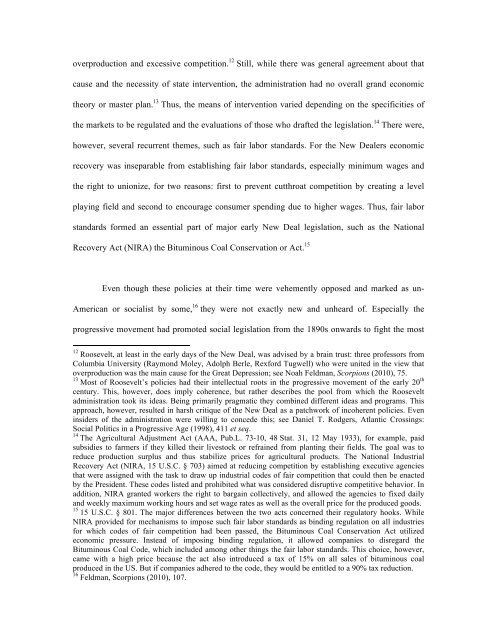Jasper Finke, Crisis and Law - New York University School of Law
Jasper Finke, Crisis and Law - New York University School of Law
Jasper Finke, Crisis and Law - New York University School of Law
Create successful ePaper yourself
Turn your PDF publications into a flip-book with our unique Google optimized e-Paper software.
overproduction <strong>and</strong> excessive competition. 12 Still, while there was general agreement about that<br />
cause <strong>and</strong> the necessity <strong>of</strong> state intervention, the administration had no overall gr<strong>and</strong> economic<br />
theory or master plan. 13 Thus, the means <strong>of</strong> intervention varied depending on the specificities <strong>of</strong><br />
the markets to be regulated <strong>and</strong> the evaluations <strong>of</strong> those who drafted the legislation. 14 There were,<br />
however, several recurrent themes, such as fair labor st<strong>and</strong>ards. For the <strong>New</strong> Dealers economic<br />
recovery was inseparable from establishing fair labor st<strong>and</strong>ards, especially minimum wages <strong>and</strong><br />
the right to unionize, for two reasons: first to prevent cutthroat competition by creating a level<br />
playing field <strong>and</strong> second to encourage consumer spending due to higher wages. Thus, fair labor<br />
st<strong>and</strong>ards formed an essential part <strong>of</strong> major early <strong>New</strong> Deal legislation, such as the National<br />
Recovery Act (NIRA) the Bituminous Coal Conservation or Act. 15<br />
Even though these policies at their time were vehemently opposed <strong>and</strong> marked as un-<br />
American or socialist by some, 16 they were not exactly new <strong>and</strong> unheard <strong>of</strong>. Especially the<br />
progressive movement had promoted social legislation from the 1890s onwards to fight the most<br />
12 Roosevelt, at least in the early days <strong>of</strong> the <strong>New</strong> Deal, was advised by a brain trust: three pr<strong>of</strong>essors from<br />
Columbia <strong>University</strong> (Raymond Moley, Adolph Berle, Rexford Tugwell) who were united in the view that<br />
overproduction was the main cause for the Great Depression; see Noah Feldman, Scorpions (2010), 75.<br />
13 Most <strong>of</strong> Roosevelt’s policies had their intellectual roots in the progressive movement <strong>of</strong> the early 20 th<br />
century. This, however, does imply coherence, but rather describes the pool from which the Roosevelt<br />
administration took its ideas. Being primarily pragmatic they combined different ideas <strong>and</strong> programs. This<br />
approach, however, resulted in harsh critique <strong>of</strong> the <strong>New</strong> Deal as a patchwork <strong>of</strong> incoherent policies. Even<br />
insiders <strong>of</strong> the administration were willing to concede this; see Daniel T. Rodgers, Atlantic Crossings:<br />
Social Politics in a Progressive Age (1998), 411 et seq.<br />
14 The Agricultural Adjustment Act (AAA, Pub.L. 73-10, 48 Stat. 31, 12 May 1933), for example, paid<br />
subsidies to farmers if they killed their livestock or refrained from planting their fields. The goal was to<br />
reduce production surplus <strong>and</strong> thus stabilize prices for agricultural products. The National Industrial<br />
Recovery Act (NIRA, 15 U.S.C. § 703) aimed at reducing competition by establishing executive agencies<br />
that were assigned with the task to draw up industrial codes <strong>of</strong> fair competition that could then be enacted<br />
by the President. These codes listed <strong>and</strong> prohibited what was considered disruptive competitive behavior. In<br />
addition, NIRA granted workers the right to bargain collectively, <strong>and</strong> allowed the agencies to fixed daily<br />
<strong>and</strong> weekly maximum working hours <strong>and</strong> set wage rates as well as the overall price for the produced goods.<br />
15 15 U.S.C. § 801. The major differences between the two acts concerned their regulatory hooks. While<br />
NIRA provided for mechanisms to impose such fair labor st<strong>and</strong>ards as binding regulation on all industries<br />
for which codes <strong>of</strong> fair competition had been passed, the Bituminous Coal Conservation Act utilized<br />
economic pressure. Instead <strong>of</strong> imposing binding regulation, it allowed companies to disregard the<br />
Bituminous Coal Code, which included among other things the fair labor st<strong>and</strong>ards. This choice, however,<br />
came with a high price because the act also introduced a tax <strong>of</strong> 15% on all sales <strong>of</strong> bituminous coal<br />
produced in the US. But if companies adhered to the code, they would be entitled to a 90% tax reduction.<br />
16 Feldman, Scorpions (2010), 107.
















